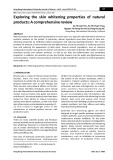
Exploring the skin whitening properties of natural products: A comprehensive reviewDo Thi Anh Thu, Ho Thi Thach Thuy, *Nguyen Thi Hong Yen and Ly Hong Huong HaHong Bang International University, VietnamABSTRACTNatural products have been gaining popularity in recent years as a safe skin-safe alternative solution to synthetic products on the market. In particular, natural ingredients have been found to have skin-whitening properties by inhibiting melanin production and reducing hyperpigmentation. This review provides the analysis of some mechanisms and effectiveness of natural products in achieving even skin tone and reducing the appearance of dark spots. Several natural ingredients, such as chemical compounds in licorice root, green tea extract, and vitamin C, have been tested for their ability to reduce tyrosinase activity and melanin synthesis, as well as for their anti-inflammatory and antioxidant properties. In addition, the selection of uses and further research into the safety and effectiveness of natural products. Overall, natural products represent a safe and effective solution to achieving brighter, more radiant skin.Keywords: skin-whitening property, melanin production, nature productsBeauty care is a topic of interest and promoon. Besides, there are many chemical beauty treatments to whiten the skin and there are also physical treatments such as laser therapy, but there are also many adverse effects on the skin. This review therefore introduces some natural skin-safe alternaves to synthec products on the market. Such as licorice root, green tea extract, and vitamin C are natural products that have been tested for their ability to reduce tyrosinase acvity and melanin synthesis, as well as for their an-inflammatory and anoxidant properes [1 - 3]. This review to highlight some of the mechanisms of natural product sources, safe products to users.1.1. ChemicalsThere are many scienfic studies and literature reviews available on the synthesis of chemicals for skin whitening. However, it is important that the use of certain chemicals for skin whitening has been linked to adverse effects and regarding their safety and efficacy [4].One class of chemicals commonly used for skin whitening is hydroquinone. Hydroquinone inhibits the producon of melanin by inhibing the acvity of the enzyme tyrosinase, which is involved in melanin synthesis. However, it can lead to side effects such as skin irritaon, ochronosis, and even carcinogenesis. As a result, some countries have banned the use of hydroquinone in skincare products or restricted its use to prescripon-only formulaons [4]. Other compounds used for skin whitening include arbun, kojic acid, and azelaic acid. These chemicals work by inhibing tyrosinase acvity or melanin synthesis, but their efficacy and safety have also been quesoned [4]. Synthec skin whitening agents are oen designed to target specific pathways involved in melanin synthesis, such as tyrosinase inhibion or melanosome transfer inhibion. On the other hand, natural products have been invesgated for their potenal as safe and effecve skin whitening agents. Many natural compounds have been shown to inhibit tyrosinase acvity and reduce melanin synthesis, such as arbun, licorice extract, and mulberry extract. Implement mechanisms, such as inhibion of tyrosinase acvity, reducon of oxidave stress and 87Hong Bang Internaonal University Journal of ScienceISSN: 2615 - 9686Hong Bang Internaonal University Journal of Science - Vol.4 - June 2023: 87-94DOI: hps://doi.org/10.59294/HIUJS.VOL.4.2023.390Corresponding Author: MSc. Ly Hong Huong Ha Email: halhh@hiu.vn1. INTRODUCTION





















